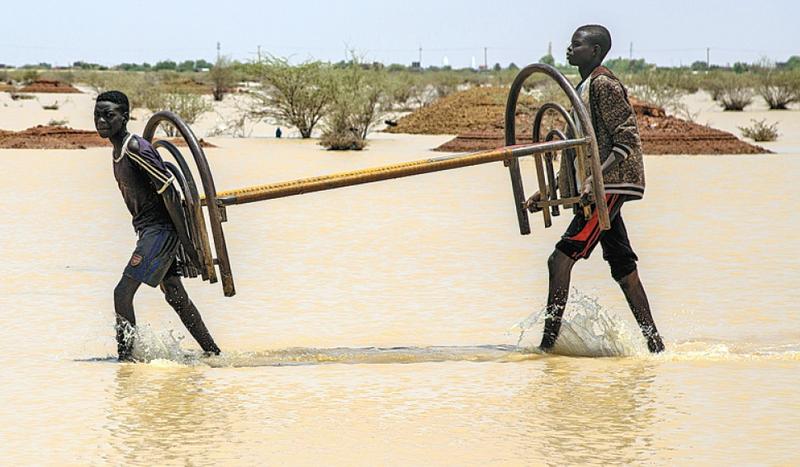 People carrying their belongings walk across a submerged area of the Sudanese capital Khartoum on Aug 3, 2020. The floods follow heavy downpours over the past week. (PHOTO / CHINA DAILY)
People carrying their belongings walk across a submerged area of the Sudanese capital Khartoum on Aug 3, 2020. The floods follow heavy downpours over the past week. (PHOTO / CHINA DAILY)
The ongoing rains in Sudan have not only resulted in flash floods and riverine flooding that have destroyed crops, houses and infrastructure but are also frustrating efforts to control the spread of coronavirus that has infected 11,738 and killed 752 as of Tuesday.
Two thirds of Sudan's population live in rural areas, and the economy is heavily dependent on agriculture
Many of the fields have been flooded in the middle of the planting season, raising concerns about food security in the country. The region in an around Khartoum, is among the hardest hit areas, the United Nation's Office for Coordination of Humanitarian Affairs said.
The Bout Earth Dam, in Blue Nile State's Tadamon locality, exceeded its full capacity and collapsed following heavy rains on Wednesday. This resulted in flooding of 12 neighborhoods downstream in Bout town, affecting around 3,900 people.
ALSO READ: Sudan finds mass grave likely linked to officers executed by Bashir
According to the Sudan Humanitarian Aid Commission, nearly 190 houses were destroyed and 590 others damaged. More houses are expected to collapse, as the rains continue in a zone where the land is already extremely wet.
The commission said the collapse of the dam was expected to compromise water access to over 84,000 people who live in the area.
At least one school, 14 boreholes and 218 latrines have also been destroyed by the flooding.
Two thirds of Sudan's population live in rural areas, and the economy is heavily dependent on agriculture.
According to the World Food Programme, 5.8 million of the country's total 43 million population are food insecure.
The Office for Coordination of Humanitarian Affairs said most of the displaced people were living with host families, and thus exposed to congestion, poor sanitation and inadequate food and other essentials, such as medicines, mosquito nets, as well as protection and maternity services.
Further flooding
Meanwhile, the Sudan Meteorological Authority has warned that more heavy rains are expected over August and September in most parts of the country, which could lead to further flooding and displacement.
Three weeks ago, the authority predicted that more than 250,000 people could be affected by heavy rains and floods during the current rainy season in the country.
Humanitarian partners and the government are already responding and supporting families with lifesaving assistance, while assessments are ongoing in all affected areas.
Logistics have been termed as the main challenge to the response efforts in the Blue Nile State, because roads are impassable and the area can be accessed only via helicopter.
Despite the challenge, the Office for Coordination of Humanitarian Affairs said at least three flights have already reached the area with emergency supplies, including medicines, hygiene kits, water purification products, mosquito nets and other nonfood items.
READ MORE: Egypt, Ethiopia and Sudan to agree on Nile dam deal in weeks
"Food, emergency shelter and other items, including kitchen utensils, are among the items that still need to be transported to the affected area," the UN body said.


